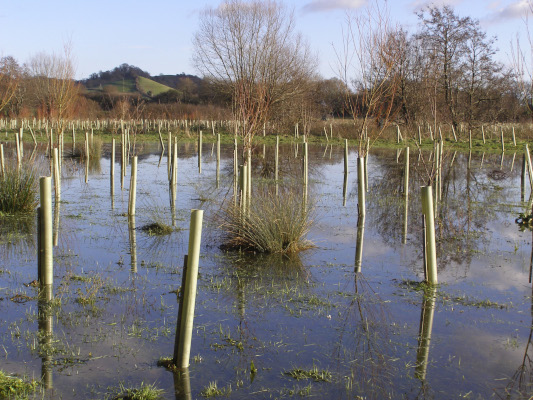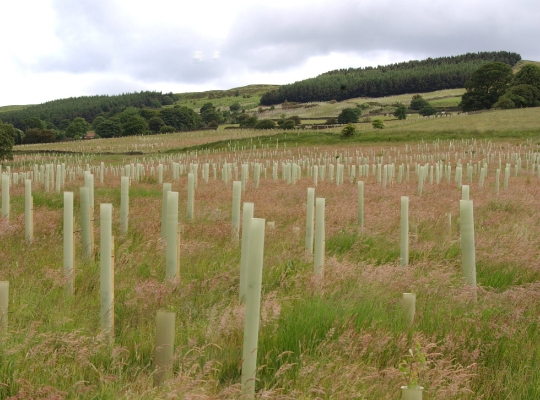Climate change
Subscribe to the Forest Research Vimeo channel
Our climate is changing, and even with strenuous global efforts to reduce greenhouse gas emissions, the UK’s climate will continue to change for decades.
Trees and forests play a vital role in climate change mitigation and can reduce the impacts of climate change on society and the environment. However, they need to be resilient to the changing climate themselves to continue providing these benefits.
About climate change
Climate change is driven by the increase in greenhouse gas (GHG) concentrations in the atmosphere. These GHGs are being released by fossil fuel use and land use changes, including deforestation. The changes to the atmosphere and the land surface are resulting in an increase in global surface temperatures, a rise in sea levels, and consequent changes in regional weather patterns, particularly temperature, rainfall and seasonality.

Climate projections
The latest UK Climate Projections (UKCP18) produced by the UK Met Office show an increased chance of milder, wetter, winters and hotter, drier summers, as well as an increase in the frequency and intensity of extreme events, such as storms, flooding, heatwaves and droughts.
The extent of climate change projected varies with the different levels of assumed emissions, which adds uncertainty to future projections. However, even with strenuous global efforts to reduce greenhouse gas emissions the UK’s climate will continue to change. The UK Climate Change Committee (2019) advise planning for a minimum of 2 °C rise in global temperature, with consideration of risks from more extreme scenarios, such as a 4 °C temperature rise before 2100.
Climate change risks
Climate change is having and will continue to have a range of impacts across the UK. The main risks to forests are drought, forest fires, windthrow, flooding, frost, pests and diseases. The level of risk varies between regions of the UK, with time into the future, and with site-specific factors. However, “without human action, it’s probable that the rate of change is greater than which our woodlands can adapt to”. (Ref: Forestry Commission: Managing England’s woodlands in a climate emergency).
Woodland owners and managers should assess the level of risks that climate change poses and implement changes to build resilience. Case studies show that across the UK many owners and managers have witnessed the direct impacts of climate change on their forest or woodland and have planned to increase resilience to the changes ahead.
Adaptation
Adaptation involves “Initiatives and measures to reduce the vulnerability of natural and human systems against actual or expected climate change effects. In the context of forestry, it means reducing the vulnerability of forests – as well as using forests to reduce the vulnerability of society to climate change.”
Appropriate adaptation measures will need to be tailored to individual sites according to management objectives, location and particular climate change risks.

Mitigation
Climate change mitigation describes the measures which reduce greenhouse gas concentrations in the atmosphere, both by decreasing their emissions and by removing greenhouse gases from the atmosphere. Woodlands and forests play a vital role in climate change mitigation by removing carbon from the atmosphere as they grow and storing it in the trees, deadwood, litter and soils, in long-lived wood products, and through the emissions avoided by using wood in construction or as a fuel. Planting new trees (afforestation) is an important part of the mitigation response advocated by the UK government and devolved administrations.
Combining adaptation & mitigation
As well as mitigating the chief causes of climate change through carbon sequestration and storage, trees and woodlands can reduce the impacts of climate change to people, property, infrastructure and the wider environment. Woodlands can reduce surface run-off after high rainfall events, improve air quality, and provide shelter, shade and cooling for people in urban areas, and for livestock and aquatic habitats in the countryside.
Trees and forests need to be resilient to climate change threats themselves in order to continue providing these ecosystem service benefits. A combination of complementary mitigation and adaptation strategies are needed to both reduce atmospheric greenhouse gas concentrations and ensure trees survive and grow well in the future climate.
Climate change tools
A free online tool from the University of Reading, used to visualise UK climate change trends and indicators of risk.
A free online tool that compares a site’s future climate to locations in Europe, and gives an indication of the climate that trees are likely to experience in the future.


